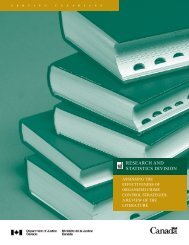National Threat Assessment 2008. Organised Crime - Politie
National Threat Assessment 2008. Organised Crime - Politie
National Threat Assessment 2008. Organised Crime - Politie
Create successful ePaper yourself
Turn your PDF publications into a flip-book with our unique Google optimized e-Paper software.
Wireless networks (WiFi) have become more common in recent years.<br />
Nowadays, wireless connections to the Internet can be made in a growing<br />
number of public locations. The downside of wireless networks is their<br />
vulnerability to hacking. Many consumers do not or hardly secure their home<br />
network. The home network signal does not stop at the front door (the exact<br />
reach of the signal is unknown). Phishers in the area can therefore pick up the<br />
signal, hack into the network and install malware on computers and/or steal<br />
identity details. Phishers can also easily hack into other people’s computers<br />
via the network in public places where several people log onto the same<br />
wireless network.<br />
A new type of phishing is called ‘vishing’ or ‘voice vishing’. VoIP (Voice over IP)<br />
systems can be used to make phone calls cheaply and anonymously via the<br />
Internet. Criminals can use VoIP to imitate a professional telephone exchange,<br />
whereby login details are entered by pressing telephone keys. Criminals use this<br />
method in two ways. In the first case an email is sent to a potential victim, as in<br />
the classic form of phishing. However, rather than a fraudulent link, a service<br />
telephone number is stated which the customer has to call in order to log on<br />
to the financial institution. In the second case, criminals call potential victims and<br />
ask them to confirm their personal details, for example, because otherwise their<br />
bank account will be cancelled. In both cases the fraudsters are after personal<br />
details that can be used to commit fraud.<br />
A further development of phishing is the use of text messages (SMS). The<br />
Internet security company McAfee has coined the term ‘SmiShing’ to describe<br />
this technique. In cases of this variant, a bank customer is asked to confirm<br />
personal details by text message. Once surfing the Internet on your mobile<br />
phone has become common practice, it will also be possible to send a (mobile)<br />
Internet link in the text message that links to a counterfeit website.<br />
All phishing techniques are aimed at misusing the stolen details. Criminals can<br />
use the stolen details to carry out all kinds of financial transactions. They use<br />
an intermediary to keep their own identity secret and still be able to transfer<br />
money to their account. These often unknowing intermediaries (who are known<br />
as ‘money mules’) are recruited via spam email or website. They are offered a job<br />
at a financial institution. The task of the employee is to make his/her account<br />
available to transfer the funds on further using a cash transfer service (usually<br />
to Eastern European countries).<br />
The Internet is used by criminals to exchange experiences, advice and techniques<br />
via chat services and in forums, for example. All the instructions and tools<br />
chapter 5 – Criminal modus operandi<br />
197








